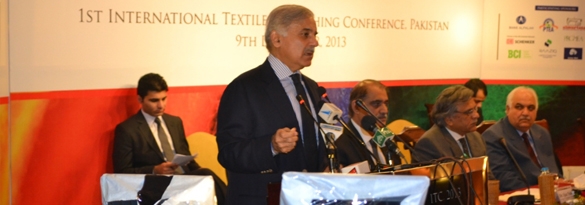newsletter
ITC 2013 Presents New Ideas For Industry Growth--Part 1
December 26, 2013 08:22 PM
Change is born from an idea. Today Pakistan is a in a unique position to capture a greater share of the textile and apparel market. In order to maximize its potential, a need for dialogue and greater collaboration between all the industry stake holders was fulfilled by the first International Textile & Clothing Conference 2013 (ITC) held on 9th December in Lahore and arranged by the Pakistan Board of Investment and Trade (PBIT) under the aegis of the Chief Minister of Punjab Shahbaz Sharif. “At a time when China has lost its competitiveness in garments due to increasing labor costs--minimum wage is $600 plus extra charges for night shifts-- and rising value of the Chinese yen, and India has not invested in its garment production, while Pakistan has achieved GSP plus status for duty free access to EU, the private sector needs to find constraint solutions that the industry faces and the government will facilitate their implementation and provide supporting infrastructure,” said Dr. Ijaz Nabi advisor to the CM. Pakistan is primarily known for being a dependable supplier for a commodity product. To increase the country’s current market share of the total $730 billion textile and clothing from 1.8 per cent or $13 billion to 3 per cent or $25 billion by 2018 according to the plan, the industry has to think outside the box and redefine its strategy. The speakers, seeing the industry from different perspectives, presented their ideas on how this can be achieved. Keynote speaker Aslam Omar, director of Brandix, Sri Lanka’s largest apparel exporter with a turnover of $600 million, supplying to Victoria’s Secret, Gap and M&S, (Matrix sources greige bottom weight fabric for Brandix) said that global apparel trade stand at $400 billion. Asia has a 64 per cent share. China dominates with 36 per cent of this. South Asia accounts for 10 per cent or $42b, with Bangladesh at 5.3, India 3.2, and Sri Lanka and Pakistan 0.9 per cent, according to UN Comtrade estimates. In 20 years between 1992 and 2012, the world population grew from five to seven billion and the industry jumped by 100 per cent from $ 185 b to $ 410 b. Keeping that in mind, in the next 20, if the population grows to 8.4 b by 2032, the industry should grow to $ 700 b, an increase of $300 b. Omar said that South Asia is the only option for significant growth in apparels because of its solid fundamentals. The combined population is larger even than China, providing a massive labor pool at a globally competitive price. The region is the largest producer of cotton and cotton yarn, while India is one of the largest producers of polyester fiber. The textile industry is highly developed; however, much of South Asian fabric is exported to East Asian countries, like Vietnam, to convert and re-export. In addition, in the past three years in each of the countries in the region, the currency has been depreciating versus the Chinese that's getting stronger. Moreover, India is a huge emerging market. The annualized growth in apparel spending for India is estimated at 11% for the next 15 years, whereas the mature markets of US and EU it will only grow 1-1.5%. A growing population, robust economy, higher disposable income, changing lifestyle and rise of women in the workforce are fuelling the higher consumption. “Global brands are responding with Gap announcing a joint venture with Arvind Brands (of India) last week. M&S CEO Marc Bolland has also stated that the company plans to make India its biggest international market,” said Omar. There is a demand for servicing the international brands that are entering the Indian market, as well as for South Asian brands. Levis director sourcing for Pakistan, Bangladesh, Mauritius and Madagascar, Murshad Alam said that for the American market, Mexico presents lead time advantages, Bangladesh is a low cost solution and Pakistan brings sustainability to the table. Sustainability has become more important for Levis today than even a lower price. This includes environment, safety, water conservation through waste water recycling and a transparency in compliance policy. The terms of engagement have changed and the brand has a uniform sourcing platform. Even in Bangladesh, the brand is insisting on a living wage for workers. In Pakistan, Levis has encouraged vendor empowerment and exceptional mills like Crescent Bahuman and US Apparel have stepped up to the plate, by even allowing hotline access to workers to encourage transparency. In the late eighties, Pakistani mills supplied knit tops to Levis, which helped develop Punjab’s knitwear industry. In the early 2000s, Levis shifted its focus to buying jeans from mills here. Today, it buys $250 million worth of jeans and $200 million in denim from Pakistan. The brand policy is to buy fabric and apparel from the same location to minimize transportation cost and carbon footprint. “The journey leading mills from being copy cat vendors to innovators producing new products, like bistretch with good recovery, is one that Levis and Pakistan mills have taken together,“ said Alam. He said that one recommendation he would make to the industry is to reduce lead time through investing in the country’s supply base depth of metal parts. At the moment, metal parts, trims and accessories, like YKK zippers, are imported from China. The industry firstly needs to increase its product range and consider categories, like lingerie and outerwear, said Munir Mashookullah, CEO of Synergies Worldwide, an apparel sourcing company. Currently, only 76 apparel products are produced by mills here. Then, retail trends such as fast fashion are driving trends in sourcing and presenting challenges, shrinking lead times from 120 days (for basics) down to two weeks (for fast fashion). “Pakistani labor is well intended, but it’s not channeled to efficiency or productivity.” Newer markets for Pakistani products should also be exploited, for example Brazil’s import of Pakistani textile goods is growing. The government needs to set up a fund and an organization that incubates entrepreneurs, bringing them together with home grown designers, financial institutions and industry mentors, suggested Aleema Khan, chairperson of Cotton Connection, a textile sourcing company. She said the role of SMEs (Small and Medium Enterprises) is essential for exports growth. Due to research and development funded by the government 65 new cotton varieties are being sown in the country, said federal secretary textiles, Rukhsana Hassan Shah. The next step will be to brand Pakistan cotton, much like Egyptian Cotton or American Supima have been done. Similarly, only 148 textile product lines out of 7800 are being produced locally. The demand for blended fabric with 60-40 polyester to cotton is on the rise in Japan, Germany and USA and this avenue also needs to be explored. APTMA (All Pakistan Textile Mills Association),executive committee member and CEO of Kohinoor Mills, Aamir Fayyaz Sheikh said to achieve APTMA target of doubling the country’s textile exports by 2018, solid measures are being taken. One is that a Sustainable Production Centre has been set up. Corporate Social Responsibility (CSR), cotton research, support and management of cotton rich products, textile education through Textile University of Pakistan (TUP) and Textile Institute of Pakistan (TIP), Better Cotton Initiative (BCI) through WWF support and energy and water conservation initiatives are all paths being pursued to reach this goal of enhanced production and export surpluses. “Most important are energy security, affordability, conservation and capacity building, because if there was no energy shortfall in the country, then $3 b of additional annual textile export could be achieved. GSP plus status will translate to $1b additional sales to EU,” said Sheikh. Since 2006, the Chinese Yen has become 30 per cent stronger against the US Dollar, while the Pakistan Rupee has lost its value by 41 per cent, making the country cheaper source. He said, "Aptma has also organized a textile and value added road show to sell Pakistan as a textile destination that will tour cities like New York City. Presidents of retailers and brands like JC Penney, Dockers, Target, etc. will be invited to attend. The US government is facilitating the American leg." Nadeem Saigol, vice president of Matrix Sourcing, said that this conference proved that in order to take advantage of the present scenario, all sectors of the industry have to come together and coordinate on policy and objectives. In the past, there has been no common platform for the textile and value added mills to meet. However, now all the stakeholders, including banks, logistics, trims and accessories suppliers, etc. can collaborate together with the industry to achieve a common goal. User Comments
No Comments posted yet!
|
Sign in HerePlease provide your Username and Password to login into the secure area.
The New Face of Sourcing! |


 Processing your request...
Processing your request...